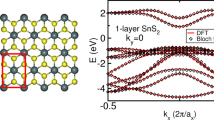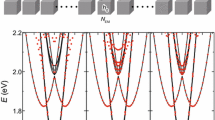Abstract
In this work, the coherent and incoherent transport simulation capabilities of the multipurpose nanodevice simulation tool NEMO5 are presented and applied on transport in tunneling field-effect transistors. The comparison with experimental resistivity data confirms the validity of NEMO5’s phonon-scattering models. Common pitfalls of numerical implementations and the applicability of common approximations of scattering self-energies are discussed. The impact of phonon-assisted tunneling on the performance of TFETs is exemplified with a concrete Si nanowire device. The communication-efficient implementation of self-energies in NEMO5 is demonstrated with a scaling comparison of self-energies solved with blocking and nonblocking MPI-communication.






Similar content being viewed by others
References
International Technology Roadmap for Semiconductors. [Online]. Available: https://www.itrs.net
Mehrotra, S., Kim, S., Kubis, T., Povolotskyi, M., Lundstrom, M.S., Klimeck, G.: Engineering nanowire n-MOSFETs at. IEEE Trans. Electron Devices 60(7), 2171–2177 (2013)
Cui, Y., Zhong, Z., Wang, D., Wang, W.U., Lieber, C.M.: High performance silicon nanowire field effect transistors. Nano Lett. 3(2), 149–152 (2003)
Appenzeller, J., Lin, Y.-M., Knoch, J., Avouris, P.: Band-to-band tunneling in carbon nanotube field-effect transistors. Phys. Rev. Lett. 93(19), 196805 (2004)
Zhu, Y., Hudait, M.K.: Low-power tunnel field effect transistors using mixed As and Sb based heterostructures. Nanotechnol. Rev. 2(6), 637–678 (2013)
Ilatikhameneh, H., Klimeck, G., Rahman, R.: Can homojunction tunnel FETs scale below 10nm? IEEE EDL 37(1), 115–118 (2016)
Sarkar, D., Xie, X., Liu, W., Cao, W., Kang, J., Gong, Y., Kraemer, S., Ajayan, P.M., Banerjee, K.: A subthermionic tunnel field-effect transistor with an atomically thin channel. Nature 526(7571), 91–95 (2015)
Li, M.O., Esseni, D., Nahas, J.J., Jena, D., Xing, H.G.: Two-dimensional heterojunction interlayer tunneling field effect transistors (Thin-TFETs). IEEE J. Electron Devices Soc. 3(3), 200–207 (2015)
Dewey, G., Chu-Kung, B., Boardman, J., Fastenau, J., Kavalieros, J., Kotlyar, R., Liu, W., Lubyshev, D., Metz, M., Mukherjee, N.: Fabrication, characterization, and physics of III-V heterojunction tunneling field effect transistors (H-TFET) for steep sub-threshold swing. IEEE Int. Electron Devices Meet. (IEDM). 33–6 (2011)
Mohata, D., Mookerjea, S., Agrawal, A., Li, Y., Mayer, T., Narayanan, V., Liu, A., Loubychev, D., Fastenau, J., Datta, S.: Experimental staggered-source and N+ pocket-doped channel III-V tunnel field-effect transistors and their scalabilities. Appl. Phys. Exp 4(2), 024105 (2011)
Trivedi, A.R., Amir, M.F., Mukhopadhyay, S.: Ultra-low power electronics with Si/Ge tunnel FET. Des. Autom. Test Eur. Conf. Exhib. (DATE) 2014, 1–6 (2014)
Zhao, Q.-T., Richter, S., Schulte-Braucks, C., Knoll, L., Blaeser, S., Luong, G.V., Trellenkamp, S., Schafer, A., Tiedemann, A., Hartmann, J.-M.: Strained Si and SiGe nanowire tunnel FETs for logic and analog applications. IEEE J. Electron Devices Soc. 3(3), 103–114 (2015)
Tomioka, K., Yoshimura, M., Fukui, T.: Steep-slope tunnel field-effect transistors using III-V nanowire/Si heterojunction. 2012 symposium on VLSI technology (VLSIT), pp. 47–48. (2012)
Kobayashi, M., Hiramoto, T.: Experimental study on quantum confinement effects in silicon nanowire metal-oxide-semiconductor field-effect transistors and single-electron transistors. J. Appl. Phys. 103(5), 053709 (2008)
Cui, Y., Lauhon, L.J., Gudiksen, M.S., Wang, J., Lieber, C.M.: Diameter-controlled synthesis of single-crystal silicon nanowires. Appl. Phys. Lett. 78(15), 2214–2216 (2001)
Lake, R., Klimeck, G., Bowen, R.C., Fernando, C., Moise, T., Kao, Y., Leng, M.: Interface roughness, polar optical phonons, and the valley current of a resonant tunneling diode. Superlattices Microstruct. 20(3), 279–285 (1996)
Roblin, P., Liou, W.-R.: Three-dimensional scattering-assisted tunneling in resonant-tunneling diodes. Phys. Rev. B 47(4), 2146 (1993)
Kubis, T., Vogl, P.: Assessment of approximations in nonequilibrium Green’s function theory. Phys. Rev. B 83(19), 195304 (2011)
Gmachl, C., Capasso, F., Sivco, D.L., Cho, A.Y.: Recent progress in quantum cascade lasers and applications. Rep. Prog. Phys. 64(11), 1533 (2001)
Luisier, M., Klimeck, G.: Simulation of nanowire tunneling transistors: from the Wentzel-Kramers-Brillouin approximation to full-band phonon-assisted tunneling. J. Appl. Phys. 107(8), 084507 (2010)
Koswatta, S.O., Lundstrom, M.S., Nikonov, D.E.: Influence of phonon scattering on the performance of p-i-n band-to-band tunneling transistors. Appl. Phys. Lett. 92(4), 043125 3 (2008)
Khayer, M.A., Lake, R.K.: Effects of band-tails on the subthreshold characteristics of nanowire band-to-band tunneling transistors. J. Appl. Phys. 110(7), 074508 (2011)
Datta, S.: Nanoscale device modeling: the Green’s function method. Superlattices Microstruct. 28(4), 253–278 (2000)
Taylor, J., Guo, H., Wang, J.: Ab initio modeling of quantum transport properties of molecular electronic devices. Phys. Rev. B 63(24), 245407 (2001)
Wang, J.-S., Wang, J., Lü, J.: Quantum thermal transport in nanostructures. Eur. Phys. J. B 62(4), 381–404 (2008)
Sadasivam, S., Che, Y., Huang, Z., Chen, L., Kumar, S., Fisher, T.S.: The atomistic Greens function method for interfacial phonon transport. Ann. Rev. Heat Transfer 17, 89–145 (2014)
Steiger, S., Veprek, R.G., Witzigmann, B.: Electroluminescence from a quantum-well LED using NEGF. In: 13th International workshop on computational electronics, IWCE’09 2009, pp. 1–4. (2009)
Stewart, D.A., Leónard, F.: Energy conversion efficiency in nanotube optoelectronics. Nano Lett. 5(2), 219–222 (2005)
Boykin, T.B., Klimeck, G., Oyafuso, F.: Valence band effective-mass expressions in the sp3d5s* empirical tight-binding model applied to a Si and Ge parametrization. Phys. Rev. B 69(11), 115201 (2004)
Jacoboni, C., Reggiani, L.: The Monte Carlo method for the solution of charge transport in semiconductors with applications to covalent materials. Rev. Mod. Phys. 55(3), 645 (1983)
Lake, R., Klimeck, G., Bowen, R.C., Jovanovic, D.: Single and multiband modeling of quantum electron transport through layered semiconductor devices. J. Appl. Phys. 81(12), 7845–7869 (1997)
Anantram, M., Lundstrom, M.S., Nikonov, D.E.: Modeling of nanoscale devices. Proc. IEEE 96(9), 1511–1550 (2008)
Springer Materials The Landolt-BörnsteinDatabase
Esposito, A., Frey, M., Schenk, A.: Quantum transport including nonparabolicity and phonon scattering: application to silicon nanowires. J. Comput. Electron. 8(3 4), 336–348 (2009)
Datta, S.: A simple kinetic equation for steady-state quantum transport. J. Phys. Condens. Matter 2(40), 8023 (1990)
Mahan, G.D.: Many-Particle Physics. Springer, New York (2013)
Steiger, S., Povolotskyi, M., Park, H.-H., Kubis, T., Klimeck, G.: Nemo5: a parallel multiscale nanoelectronics modeling tool. IEEE Trans Nano 10, 1464 (2011)
Niquet, Y.-M., Nguyen, V.-H., Triozon, F., Duchemin, I., Nier, O., Rideau, D.: Quantum calculations of the carrier mobility: methodology. Matthiessens rule, and comparison with semi-classical approaches. J. Appl. Phys. 115(5), 054512 (2014)
[Online].Available: http://www.ncsa.illinois.edu/enabling/bluewaters
Luisier, M.: A parallel implementation of electron-phonon scattering in nanoelectronic devices up to 95k cores. In: 2010 International conference for high performance computing, networking, storage and analysis (SC), pp. 1–11. (2010)
Thurber, W. R.: The relationship between resistivity and dopant density for phosphorus-and boron-doped silicon, 400(64). US Department of Commerce, National Bureau of Standards, (1981)
Learning and research in the cloud” Published online 07 November 2013, Nature Nanotechnology, 8, 786–789 (2013). doi:10.1038/nnano.2013.231
nanoHUB.org: cloud-based services for nanoscale modeling, simulation, and education, Nanotechnology Reviews, 2(1), 107–117 (2013). doi:10.1515/ntrev-2012-0043. ISSN (Online) 2191-9097, ISSN (Print) 2191-9089
Acknowledgments
The use of nanoHUB.org computational resources operated by the Network for Computational Nanotechnology, funded by the US National Science Foundation under Grant Nos. EEC-0228390, EEC-1227110, EEC-0228390, EEC-0634750, OCI-0438246, OCI-0832623, and OCI-0721680, is gratefully acknowledged. NEMO5 developments were critically supported by an NSF Peta-Apps award OCI-0749140 and by Intel Corp. This work was supported in part by funding from the Semiconductor Research Corporation’s Global Research Collaboration (GRC) (2653.001), and Member Specific Research Intel (MSR-Intel) (2434.001). Additional funding was provided by the Semiconductor Research Corporation membership in the Network for Computational Nanotechnology. This research is part of the Blue Waters’ sustained-petascale computing project, which is supported by the National Science Foundation (award number ACI 1238993) and the state of Illinois. Blue Waters is a joint effort of the University of Illinois at Urbana-Champaign and its National Center for Supercomputing Applications. This work is also part of the “Accelerating Nano-scale Transistor Innovation with NEMO5 on Blue Waters” PRAC allocation support by the National Science Foundation (award number OCI-0832623). This research was supported in part through computational resources provided by Information Technology at Purdue University, West Lafayette, Indiana.
Author information
Authors and Affiliations
Corresponding author
Rights and permissions
About this article
Cite this article
Charles, J., Sarangapani, P., Golizadeh-Mojarad, R. et al. Incoherent transport in NEMO5: realistic and efficient scattering on phonons. J Comput Electron 15, 1123–1129 (2016). https://doi.org/10.1007/s10825-016-0845-y
Published:
Issue Date:
DOI: https://doi.org/10.1007/s10825-016-0845-y




